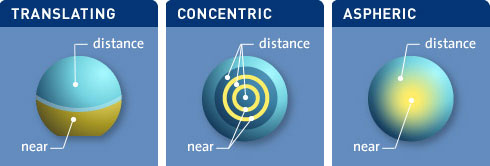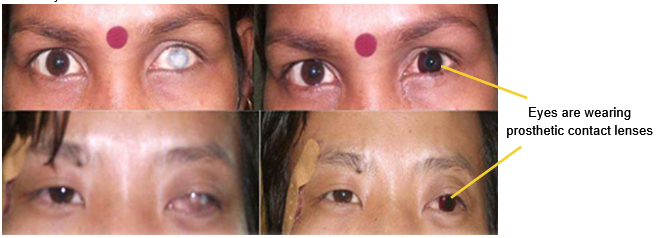 |
Contact lenses are thin curved plastic sheets which are placed on the cornea. The aim of wearing them is to correct refractive error or therapeutic. Many people also wear them to look beautiful.
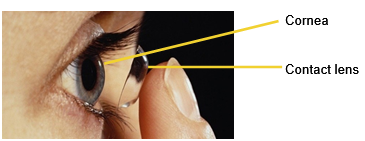 |
Until now, optical technology has grown by leaps and bounds. As a result, there are many types of contact lenses sold in the market today.
Before consuming the item, there are a few things you should consider:
- Type of your nearsightedness. For example, astigmatism is more suitable to wear RGP contact lenses or toric contact lenses.
- Lifestyle / work. For those who work in a dusty and dirty environment, they cannot wear any contact lenses.
- Personal interests. Soft lenses are preferred over RGP as they are softer and more comfortable.
- Time to wear contact lenses. Take into consideration how long you are going to wear the contact lenses for the day and the time required to keep and maintain the contact lens.
First of all, you have to determine whether your eyes are suitable to wear the contact lens. Therefore, all contact lenses users must undergo an eye examination prior to wearing them. Use this opportunity to discuss with any optometrist on the appropriate contact lenses.
Types of contact lenses
1. Soft contact lenses
Soft contact lenses are made of soft plastic (hydrogel). They are flexible and can absorb water. Many people feel comfortable wearing these lenses. However, these kinds of lenses are easy to tear.
Dirt like simple protein deposits can form on the lens’ surface. Therefore, we have to wash thoroughly to remove it. If it is still dirty, use a protein remover once a week.
However, the size of the soft contact lens is limited. If the size does not fit on the eyes, problems can occur.
For example, tight fitting of soft contact lenses may cause pain to the eyes. In some cases, there are reports on blurring of vision. Therefore, it is important to get your eyes examined before wearing the contact lenses.
The latest material for soft contact lenses is silicone hydrogel. Silicone hydrogel lenses are better than other soft contact lenses.
This is because the material has high oxygen permeability. When more oxygen penetrates into the cornea, the eyes are healthy. Due to that reason, the silicone hydrogel lenses can be worn longer.
2. Semi-hard or RGP Lenses (Rigid Gas Permeable)
For someone who wants his eye to stay healthy, RGP is the best choice. RGP lenses are made from rigid plastic and contain no water.
RGP lenses are smaller in size than soft contact lenses. It has a diameter that does not exceed 10 mm. This allows more oxygen to enter into the cornea.
It is very difficult for deposits or dirts to form on the surface of RGP lenses. This can reduce the risk of eye infections.
However, the nature of RGP lens is semi hard. People who wear it will feel less comfortable and will take a longer time to adapt.
Each RGP is custom made to the shape of the cornea. So, wearing RGP can provide sharper vision. Therefore, RGP is the best contact lens to overcome astigmatism and presbyopia.
The normal RGP can correct astigmatism up to 3DC power. Whereas, for power more than 3DC, toric RGP is needed.
Eye diseases like keratoconus, has an uneven surface of cornea. The cornea has become thinner and it bulges forward. As a result, the eye with keratoconus has very high astigmatism.
Unlike normal eyes, glasses alone, cannot help to see clearly. Patients with keratoconus have to wear RGP. RGP can also slow down the process of protrusion of the cornea.
Orthokeratology (Ortho-K)
If you have refractive error, but do not want to wear glasses or contact lenses during the day, and also if you do not want to take the risk of surgery or laser treatment, you can try Ortho-K.
Ortho-K uses special RGP to change the shape of the cornea. This Ortho-K lens is worn for 8 hours during sleep. After waking up, the eye would see as natural.
However, this situation is temporary. So, one has to use it every night.
3. Hybrid Contact Lenses
It is the latest contact lens in the market. The hybrid contact lenses combine two materials. In the central region, RGP material is used and is surrounded by a hydrogel material.
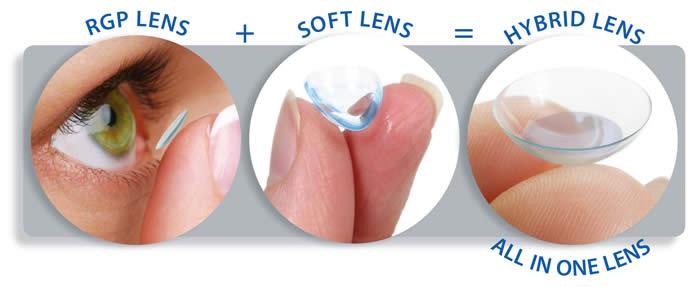 |
RGP materials can provide better quality of vision. Whereas the material of hydrogel provides comfort to the wearer.
Other types of contact lenses of different designs
Contact lenses can be ordered according to the size or shape of the cornea and refractive power. For example, for the small sized cornea, the contact lens that should be worn is with a small diameter. As for presbyopia, one can try bifocal or multifocal contact lenses.
Below are the types of contact lenses based on various designs:
- Spherical contact lens. It has a spherical shape and can correct the myopia and hyperopia.
- Toric contact lenses. This type is suitable for high astigmatism.
- Bifocal contact lenses.
As shown in the picture, it has 2 power segments. The upper segment is the power of distance, while the lower segment is the power of nearness.
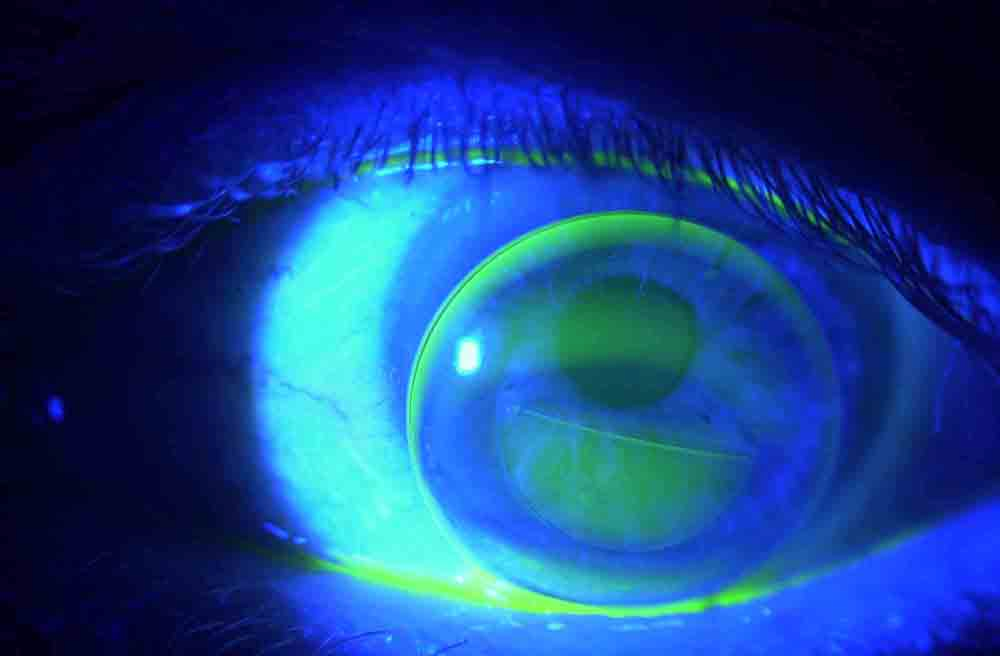 Eye is wearing a bifocal contact lens Eye is wearing a bifocal contact lens |
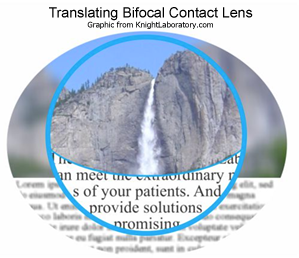 |
When the eye is looking at distant objects, the eye will use the upper segment. For reading purposes, person will look down without moving his head. The bifocal contact lens is shifted upwards and the eyes will see using the lower segment.
4. Multifocal contact lenses
Such as glasses. Multifocal contact lenses have few power zones for near
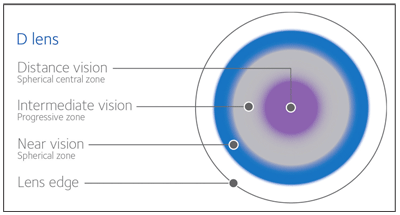 |
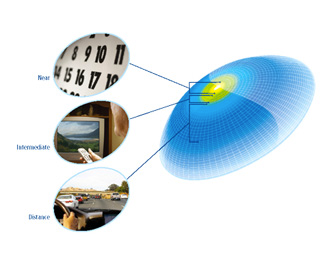 |
5. Coloured contact lenses
Many people who do not have any refractive error, are now wearing coloured contact lenses. It is now a trend to wear coloured contact lenses. They look more stylish and attractive. For example, the pupil which has its original brown colour will turn to blue by wearing the coloured contact lenses.
6. Prosthetic contact lens
Coloured contact lens that is used for medical purposes is called a prosthetic contact lens.
As shown below, prosthetic contact lenses are worn to cover such defects. In fact, it looks similar to a normal eye. Patients also feel more confident.
Mode of Wearing Time
Each manufacturer has a specific mode for wearing each lens. All users must comply with the suggested time frame. Refer to the instructions on the box before wearing them.
Generally, soft contact lenses can be worn for 8 to 12 hours a day. There are 2 types of mode for wearing soft contact lenses:
Daily wear contact lens. This contact lens is worn in the morning and removed at night. It is the most common type in the market and lasts for one year. Please remove it before going to bed even when taking a short nap.
Extended wear soft contact lens is made of soft silicone with high oxygen permeability. These properties allow this type of contact lens to be worn for more than 14 hours. This contact lens can also be used continuously for several days. It only needs to be removed once a week to relax the eyes.
For example, focus night and day is worn continuously for 6 days and removed on the seventh day. This method is repeated on the next day. After a month, the lenses should be discarded and replaced with a new one.
Unfortunately, wearing contact lenses overnight is not good for the eyes. Wearing them while sleeping will increase the risk of eye disease.
The RGP lenses can be worn up to 16 hours a day. Remember, not all eyes can wear contact lenses until the maximum time duration.
If the eyes turn red after a period of time, remove your contact lenses.
For example, after wearing the contact lenses for 8 hours, the eyes appear red and you feel uncomfortable. So, your limit of wearing the contact lenses in a day is 8 hours only.
It is also important to rest the eyes from wearing contact lenses at least one day in a week. Make sure your glasses are also available for any emergencies. This is to ensure the health of the cornea is maintained.
The cornea has five layers. Each layer must stay transparent without any opacity. Oxygen plays an important role in this process.
Problems occur when the cornea of ??the eye does not get enough oxygen. The cornea will become weak and bacteria will easily penetrate into the eye. Subsequently infection can occur.
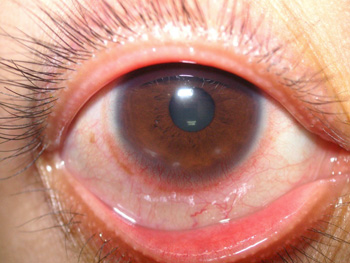 |
The other complications are cornea scar, opaque cornea, the growth of new blood vessels and corneal ulcers. In severe cases, the eye can become blind permanently.
When should your contact lenses be discarded?
Each lens has certain life span. Although it has been treated with care, contact lenses should be replaced over a period of time.
After a while, the contact lenses change its form and nature. Moreover, deposits and impurities have covered the surface of the contact lenses. This condition may increase the risk of eye disease and less sense of comfort.
Removal and replacement frequency for soft contact lenses are classified as follows:
Daily disposable lenses: discarded after one day of wearing. Has the lowest risk of infection because the eyes always use a new one.
Disposable lenses: discarded and replaced every two weeks or every month. These types of contact lenses are mostly worn as daily wear basis.
Frequent replacement lenses: discarded after one month.
Conventional lenses: The most commonly used because it is cost effective. They are discarded and replaced every year. However, care and proper hygiene must be taken seriously.
RGP is the most durable contact lenses that can last up to two years. Provided that the users comply with the hygiene requirements of RGP.
References
- http://focalpointeeyecare.com/contact-lenses/speciality-contacts/
- http://visiqueoptometrist.co.nz/orthokeratology/
- http://www.pasadenaeye.com/services/contact-lenses/
- http://www.gizmag.com/stem-cell-contact-lens/11855/
- http://www.mulqueenyeyecenters.com/blog/tags/contact-lenses-st-louis-mo
- http://westsideoptometrynow.com/tag/bifocal-contact-lenses/
- http://www.theeyepractice.com.au/optometrist-sydney/multifocal-contact-lenses-for-your-eye-condition
- http://www.kiyanoptometric.com/contact-presbyopia.html
- http://www.reviewofcontactlenses.com/
- http://www.seethedetails.co.uk/air_optix_aqua_multifocal
- http://www.artificialeyeco.com/prosthetic-contact-lens.php
- http://www.eyecenter.com.ph/cornea-external-diseases.html
| Last Reviewed | : | 17 Disember 2015 |
| Writer | : | Pn. Lily Muhanifa Binti Mustafa |
| Translator | : | Pn. Lily Muhanifa Binti Mustafa |
| Accreditor | : | Pn. Noor Zahirah Binti Husain |




